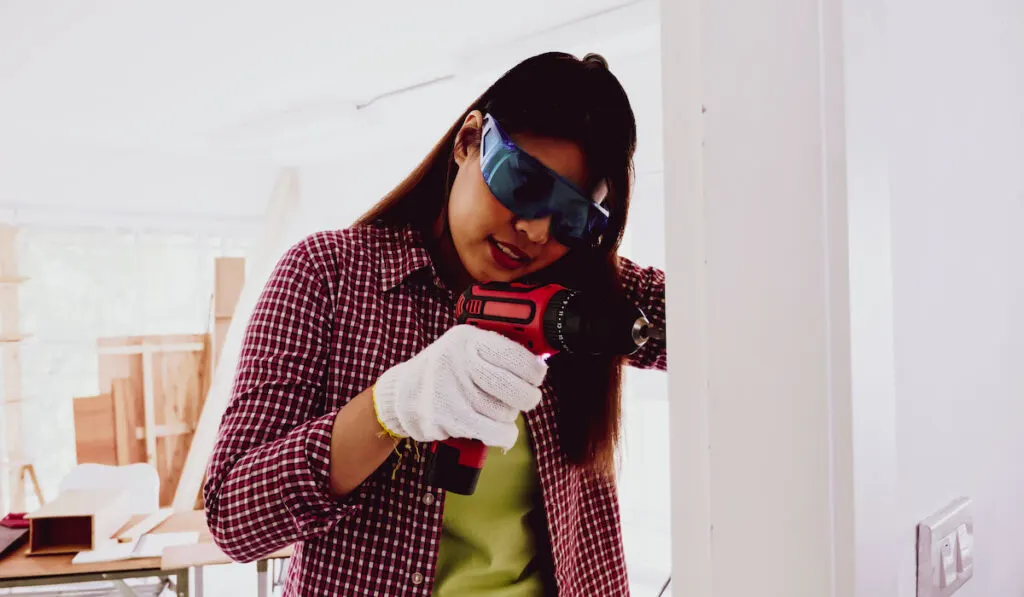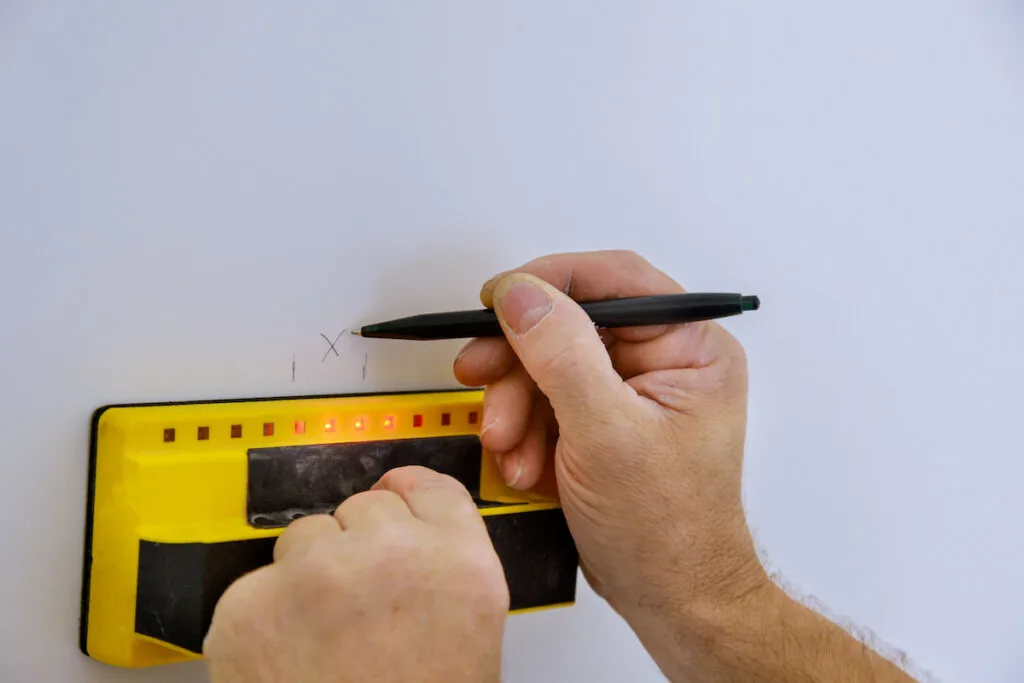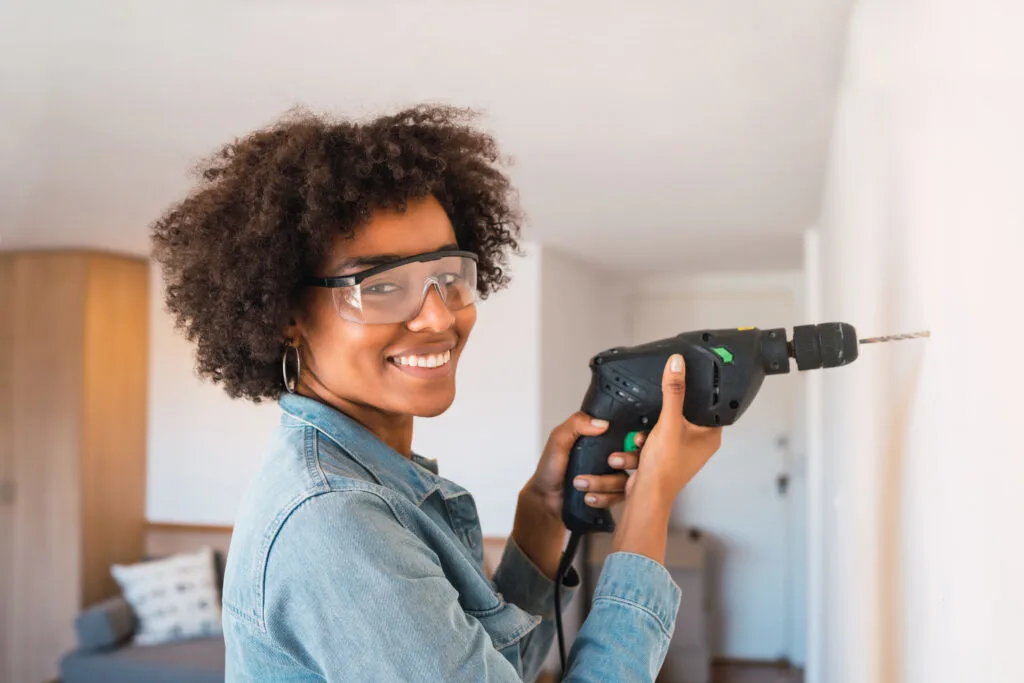*This post may have affiliate links, which means I may receive commissions if you choose to purchase through links I provide (at no extra cost to you). As an Amazon Associate, I earn from qualifying purchases. Please read my disclaimer for additional details.
There are many home improvement projects that may require you to drill a hole into your wall, whether it’s securing furniture, mounting a television, or hanging a picture. Depending on the project, you may or may not be aiming to hit a stud. How do you know when you drill into one?
When you hit a stud with your drill bit, you will feel resistance or it might stick and not go any further. Drilling a small hole in a stud for a screw to a hang a picture will not affect the stud, however, if you are planning any larger drilling projects, you may want to check for studs as drilling into one could compromise its integrity.
In this article, we will address whether or not it’s okay to drill into a stud, how to avoid hitting a stud, and when it’s a good idea to locate a stud for drilling.
Additionally, we will cover alternatives to drilling into a stud, how to tell the difference between hitting a stud or a pipe, and how many times you can drill into a stud.

Table of Contents
Is It Okay to Drill Into a Stud?
Drilling small holes partway into a stud should not affect a studs integrity. Typically this would be done to ensure the stud doesn’t crack when placing a screw into the wall.
If you want to hang a picture on the wall and you don’t have any drywall screws/anchors, you will want to find a stud to secure your hanging fixture. This way the weight of the wall decoration doesn’t tear through the drywall.
This is especially true for any heavy wall hangings like large, framed artwork or mirrors, as an example.
If you are looking to drill a large hole into a stud, especially if it goes all the way through, you will want to check with a professional first. Large holes can create weak spots.
Since the studs are set into the wall to provide structural integrity, you may be weakening the wall itself by drilling a large hole through the stud.
How Can I Avoid Hitting a Stud While Drilling?
If you want to make sure that you don’t hit a stud while drilling, there are a couple of ways to locate where a stud is placed in the wall without needing to see the inside of the wall.
The first rudimentary way to find a stud is by knocking on the wall. If the returning sound is hollow, you’re on pure drywall. Move horizontally along the wall and keep knocking until the hollow sound turns solid. Once you’ve hit a solid spot, you’ll know you’re in front of a stud.
Of course, this method isn’t 100% accurate. The sound of the wall can change depending on what is behind it, whether the wall has insulation, etc.
The most accurate way to locate studs in a wall is by using a stud finder.
Place the tool flush with the wall and press down on the button while slowly dragging it horizontally across the wall. When the stud finder beeps and lights up, you’ve hit a stud.
Studs are usually placed every sixteen to twenty-four inches apart so you can have an idea of how the wall is set up and what places to avoid when you want to drill.

Can I Purposely Drill a Hole Into a Stud?
There are many reasons to drill a hole in a stud. You can purposefully drill a hole into a stud, but you must be aware of the potential consequences that can arise.
Sometimes, you need to put a hole through a stud in order to thread electrical wires through it. Make sure you consult an electrician or professional contractor before doing so.
They will be able to recommend the appropriate size to drill the hole as well as the best places in the stud to drill it to avoid weakening the board.
If you are running plumbing through a stud, most times plumbing experts will recommend using double studs in these walls.
Contact a professional plumber to see if you need to add studs to an existing wall in order to bolster it before installing any pipes.

What Should I Do Instead of Drilling Into a Stud?
If you want to hang a picture or mount your television on the wall, sometimes it’s not convenient for aesthetic placement to drill into a stud. If you don’t have the security of a stud, how can you hang something on the drywall without it tearing the wall?
Drywall screws are made for securing wall hangings in place without having to drill into a stud. If you want to actively avoid a stud as some television brands recommend, then use a stud finder and secure the wall mounts in between the studs with the hardware they provide.
Alternatively, for lighter weight wall decorations, you may not have to drill into the wall at all. Hooks that stick to the wall with strong double sided adhesive may be sufficient.
How Do I Know If I Hit a Stud or a Pipe While Drilling?
You will be able to easily tell the difference between hitting a pipe and hitting a stud if you’re drilling a hole in your wall. When you hit a stud, the drill will slow, or you will feel resistance, but the tip should still go through (unless you’ve hit a knot).
If you hit a pipe, the drill will stop completely, and you may hear the sound of metal on metal. Some pipes in the wall made be PVC. If your drill gets stopped, don’t keep drilling. You could damage the PVC pipe or even begin to drill a hole through it.
The best way to avoid hitting a pipe in the wall is by getting a stud detector that will identify metal so you can track where the pipe is. Alternatively, you may need to pull up the blueprints of the house so that you know exactly where you are drilling.

How Many Times Can You Drill Through a Stud?
If you are simply drilling a hole in a stud to hang wall décor, the number of holes you drill for screws will not make that much of a difference in the stud’s integrity. However, if you need to drill holes for electrical wiring, it’s important to comply with certain rules to ensure that the strength of the stud isn’t compromised.
You can drill multiple holes the length of the stud to run electrical wire, but never drill holes side by side unless you use steel plating to reinforce them. Even then, make sure it is absolutely necessary to drill side by side before doing so.
As long as the holes are not stacked too close together, you can safely drill up to half a dozen or even more holes in a stud. Always check with an electrician, general contractor, or structural engineer to make sure that you aren’t severely weakening the integrity of the stud by drilling too many holes.
Conclusion
If you drill into the wall and feel resistance against the bit, you’ve probably hit a stud. Drill bits will punch right through drywall without any pushback. If you need to locate a stud to avoid or purposefully hit it with your drill, use a stud finder to help you out.
Never drill too big or too many holes into a stud as you may compromise the integrity of the stud itself.
